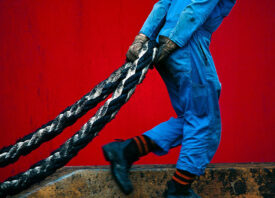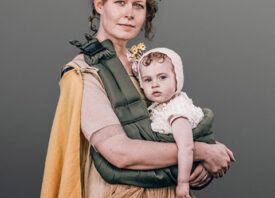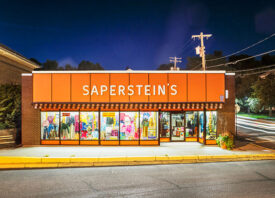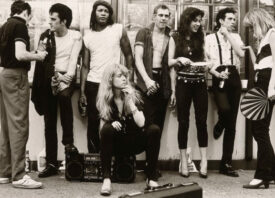Search this site
Talking Lenses and Time Travel With Photographer Jay P. Morgan (Sponsored)


Where most photographers spend their time capturing the world that surrounds them, Los Angeles-based Jay P. Morgan works day and night to create universes that are entirely his own. With an extensive background in film, set design, and lighting, the photographer has created dramatic and unforgettable images for countless high-profile clients ranging from Paramount Pictures, Disney Inc., and 20th Century Fox to Dunkin Donuts and McDonalds.
Over the course of his quarter century in the business, Morgan has not only dominated the commercial industry but also carved out time for his personal projects, many of which require building and lighting stage sets from the ground up. Part of what makes Morgan such a strong contemporary voice is his respect and reverence for the past, as illustrated in his Time Period series. Here, he plays the role of the time traveler, reconstructing historic backdrops and imagining the stories that could have unfolded before them. Whether he’s taking us along on a journey across the Oregon Trail or to the saloons of the Wild West, Morgan is able to tell tales of conflict, romance, and redemption within a single frame.
In addition to juggling his various projects, Morgan also maintains The Slanted Lens, a website through which he gives us a glimpse behind the scenes at some of his most ambitious shoots. His video tutorials are a playful as they are educational, with humor and wisdom dispersed in equal measure. One of his secret weapons is his masterful understanding of lenses, their inestimable value and their applications. We spoke to him about setting a scene, pushing through comfort zones, and trusting Tamron lenses to capture the magic.
You put a lot of time into set design and lighting. Could you walk us through one of the most elaborate shoots you’ve done?
“The creative process for me is a journey that after 25 years is still difficult, challenging and deeply satisfying. I am always in fear that this is the time that things will not work out. That fear is what keeps me sharp and pushes me through the challenges of each shoot. The exhilaration I feel when I see a finished image is an emotional experience that I cannot even begin to describe. That feeling is what draws me back to the process again and again. If I did not feel the emotional connection that I do to my images, I could not overcome the fear I feel when I shoot and would not shoot again.
“One of the first images that I did in my Time Period series was an ode to Edward Hopper’s “Night Hawks.” The set was a tremendous amount of work and created in detail from scratch. We constructed and painted the walls and the counter. Signage was found or created to give believability to the scene. Plexiglass was placed in the windows simply to hold the signs in place. I had the stylist look for coffee urns that would match Edward Hopper’s Night Hawks. All the props, wardrobe and set dressings were compiled and the restaurant was created. All the little details needed to be just right. Looking at old B&W images for inspiration, the stylist and I worked to get everything just right. The painter said as we were finishing up that his dad had an old car that would look great in this image. The car was the perfect accent to the shot.
“On a project like this, we take a day to light and a day to shoot. The evening after we had lit the set, I sat alone and just looked at this incredible scene that we had created and felt so excited to shoot the next day. I felt like I was looking back in time. I felt pretty sad at the same time knowing that it would all be torn down in a couple of days.
“I can’t tell you why I shot this image. It was a tremendous amount of money and had no practical commercial use. I felt driven to make the image, so I did. I don’t know what else to say. I wanted each person in the image to have a story. And to cause the viewer to reflect on who they were and why they were here. It feels lonely and I wanted people to relate to a time when they felt lonely being around people they did not know. I do feel guilty because I found a cup and saucer in the prop room a couple of years later that had not been returned to the prop house. I’m sure we paid for it when we did not return it. I could not bring my self to return it. It sits on a shelf in my office as a reminder of the image and the feeling I had when we created the image. I guess that is my confession for the day.”


Could you tell us a bit about Time Period? What inspired you to embark on this project? What periods excite you the most?
“I want to create visual experiences that move people back in time and cause them to feel what a person may have felt on a random day in another time. Who we are and what we have accomplished is because of what people have done before us. I feel very connected to the past. I think I inherited my mother’s love of antiques. I have always loved history and feel that things and places speak about the people who once lived in the time and used the things. Individuals making difficult decisions in singular moments have accomplished momentous events in history. I love trying to recreate those moments. I guess on some level I was a hipster long before it was popular.
“My favorite time periods are the early to mid 1900’s and the old west. There is something about the people and the things that surrounded them that are fascinating.”

How much research has gone into this project?
“I look at old images from the period. I talk to people who remember the eras and of course I talk with re-enactors. They are a wealth of information. They love the time as much as I do and have immersed their lives in the time.”
Could you tell us a bit about The Slanted Lens? What motivates you to take your photography that step further and to share your secrets with others?
“I started making videos about my work 3 years ago when an art director asked me to shoot a behind-the-scenes video about one of my images. He said, “people want to see you work and understand your process better.” I did one, and it got a great response online, so I decided to start sharing more about my process. I love seeing what others do and hope that showing what I do will inspire others. I love light and want to share that passion with others. I want The Slanted Lens to help people gain the tools necessary to reach their creative goals.”
We love that you have such a sense of humor. Why is it important to keep things light-hearted in this industry?
“I have never taken myself too seriously. I take what I do very seriously, but I love to make people laugh as the outcome. It’s so fun. Someone made a meme of the talent falling through a seamless as I talk away. It’s had 3 million views. I love it.”

How does working in video and film inform your still photography?
“I love telling stories. My still images try and tell a whole story in one image. Moving to film is like opening the door to so many possibilities that are not possible in stills. The two fields strengthen each other. My frames are more visually strong because of photography and my story telling is better because of film. They help each other. It’s the perfect union.”
Your process is impressively meticulous. Why is it important to you to have a hand in everything you produce, from lighting to set design?
“It’s an art project to me, and I want to see and feel myself in every detail. I have the vision and need to chart the course.”
Speaking of being meticulous, how do you go about finding the perfect lens to capture your creations?
“Choosing a lens is a critical part of the creative process. Do I want this to feel funny or intimate? Do I want to see the person in context of their surroundings or do I want to relate to them intimately with nothing distracting from that experience? The lens can help communicate your artistic intention and moves you closer to your goals. It’s a critical decision.”

Do you have any anecdotes about how your favorite lens has helped you along the way? What separates a mediocre lens from an excellent one?
“A good lens does not take away from the process. It’s sharp, fast, and functions under any circumstances. A good lens is a support to your vision, a support that can be loud at times and very quiet at others. It visually lets the world in so the creative process can begin.”
How long have you been using Tamron lenses, and what do you love about them?
“I have been using Tamron lenses for 4 years. I love the sharpness of the glass, clean color and the ease of use. Their SP lenses have become the backbone of our creative process. They are cost effective so I can afford to keep 3 to 5 cameras shooting at the same time.”

How many Tamron lenses do you own, and which ones would you say you use most often?
“I own 12 to 15 Tamron lenses. The SP 24-70mm lens is my go to lens. It’s a good walk around lens and at 2.8 on a full frame it gives me complete creative control. I also love the SP 70-200mm lens. A two-camera interview with two of these lenses creates a beautiful look, as the background falls out of focus.”
Any projects in the works you’re excited about getting started on in the near future?
“We are working on being at Gettysburg later this year and I am very excited about the possibilities. It should fabulous.”




